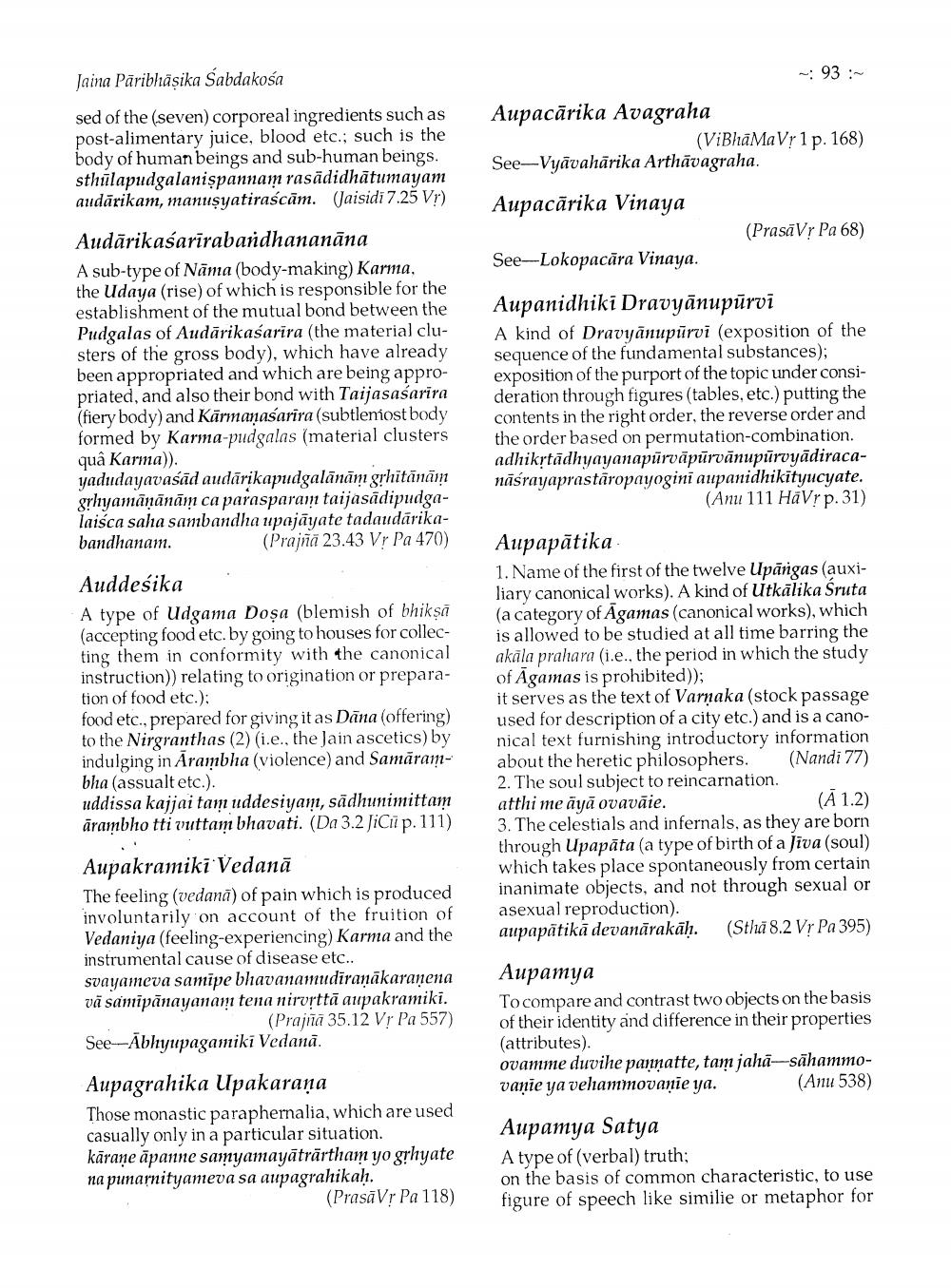________________
Jaina Pāribhäsika Sabdakosa
- 93 :
sed of the (seven) corporeal ingredients such as post-alimentary juice, blood etc.; such is the body of human beings and sub-human beings. sthilapudgalanişpannam rasādidhātumayam audārikam, manusyatiraścām. (Jaisidi 7.25 Vr)
Aupacārika Avagraha
(ViBhaMaVr 1 p. 168) See-Vyāvahārika Arthāvagraha.
Aupacārika Vinaya
(PrasãV? Pa 68)
See-Lokopacāra Vinaya.
Audārikasarīrabardhananāna A sub-type of Nāma (body-making) Karma, the Udaya (rise) of which is responsible for the establishment of the mutual bond between the Pudgalas of Audārikasarira (the material clusters of the gross body), which have already been appropriated and which are being appropriated, and also their bond with Taijasaśarira (fiery body) and Kārmanasarira (subtlemost body formed by Karma-pudgalas (material clusters quâ Karma)). yadudayavasād audārikapudgalānām grhitānām gyhyamāṇānām ca parasparam taijasadipudgalaiśca saha sambandha upajāyate tadaudārikabandhanam.
(Prajňa 23.43 V? Pa 470)
Aupanidhiki Dravyānupūrvi A kind of Dravyānupūrvi (exposition of the sequence of the fundamental substances); exposition of the purport of the topic under consideration through figures (tables, etc.) putting the contents in the right order, the reverse order and the order based on permutation-combination. adhikytādhyayanapurvāpūrvānupūrvyādiracanasrayaprastāropayogini aupanidhikityucyate.
(Anu 111 HÔVrp.31)
Auddesika A type of Udgama Dosa (blemish of bhikṣā (accepting food etc. by going to houses for collecting them in conformity with the canonical instruction)) relating to origination or preparation of food etc.); food etc., prepared for giving it as Dāna (offering) to the Nirgranthas (2) (i.e., the Jain ascetics) by indulging in Arambha (violence) and Samārambha (assualt etc.). uddissa kajjai tam uddesiyam, sādhunimittam ārambho tti vuttam bhavati. (Da 3.2 JiCup. 111)
Aupapātika 1. Name of the first of the twelve Upāngas (auxiliary canonical works). A kind of Utkālika Sruta (a category of Agamas (canonical works), which is allowed to be studied at all time barring the akāla prahara (i.e., the period in which the study of Agamas is prohibited)); it serves as the text of Varnaka (stock passage used for description of a city etc.) and is a canonical text furnishing introductory information about the heretic philosophers. (Nandi 77) 2. The soul subject to reincarnation atthi me āyā ovavāie.
. (Ā 1.2 3. The celestials and infernals, as they are born through Upapāta (a type of birth of a Jiva (soul) which takes place spontaneously from certain inanimate objects, and not through sexual or asexual reproduction). aupapātikā devanārakāh. (Sthä 8.2 Vr Pa 395)
Aupakrainiki Vedanữ The feeling (vedanā) of pain which is produced involuntarily on account of the fruition of Vedaniya (feeling-experiencing) Karma and the instrumental cause of disease etc.. svayameva samipe bhavanamudiranākaranena vä samipānayanam tena nirurttā aupakramiki.
(Prajna 35.12 Vr Pa 557) See-Abhyupagamiki Vedanā.
Аиpaтya To compare and contrast two objects on the basis of their identity and difference in their properties (attributes). ovamme duvihe pannatte, tam jahā-sähammovanie ya vehammovanie ya. (Anu 538)
Aupagrahika Upakarana Those monastic paraphernalia, which are used casually only in a particular situation. kärane āpanne samyamayātrārtham yo grhyate na punarnityameva sa aupagrahikah.
(PrasāV? Pa 118)
Aupamya Satya A type of (verbal) truth; on the basis of common characteristic, to use figure of speech like similie or metaphor for




